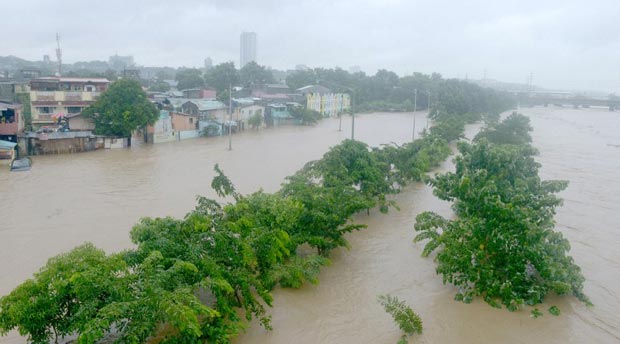
Floods waters from Marikina river (R) overflows to a street along the river and residences (L) in the suburbs of Manila on September 19, 2014. Heavy rains brought by the outer bands of Tropical Storm Fung-Wong shut down the Philippine capital on September 19, stranding motorists and forcing tens of thousands to flee their flooded homes, officials said. AFP
Typhoon “Luis” and Tropical Storm “Mario” together exacted a heavy toll on farms amounting to P1.14 billion so far, based on an initial assessment by the Department of Agriculture (DA).
The DA said that as of noon on Saturday, rice farms suffered the worst with some 53,800 tons of palay worth an estimated P934 million lost.
But of the 99,875 hectares of rice farms affected, 96,046 hectares showed promise of recovery.
Also ravaged were P150.6-million worth of corn, equivalent to almost 11,566 tons of harvest.
The DA said all but 13 hectares of the 21,321 hectares of affected corn farms had a chance of recovery.
Another 1,883 tons of high-value crops—such as fruits and vegetables—worth P41.8 million were lost to the two howlers.
On the other hand, the fisheries subsector lost P12.2 million, while some P3.6-million worth of fishery facilities were also damaged.
Livestock growers reported P2.3 million in losses.
Central Luzon reported the biggest loss among the five affected regions—including the Cordilleras, Ilocos, Cagayan Valley and Bicol—with P606.8 million.
Nueva Ecija bore the brunt of the bad weather, losing P254.4-million worth of crops, including P237-million worth of palay.
According to the DA, the combined damage from Luis and Mario meant a reduction in rice production by 0.28 percent from the full-year target of 19.07 million tons.
The toll of Luis and Mario on rice output accounts for 0.73 percent of the 7.3-million ton forecast for the fourth quarter of 2014.
In a related development, the Philippines may be dodging a major blow to local food production as the threat of an El Niño still looms but is likely to be weak with the impact to be felt more in the southern hemisphere.
According to the Agricultural Market Information System, the latest outlook from the Australian Bureau of Meteorology, the International Research Institute for Climate and Society, and the US National Oceanic and Atmospheric Administration continued to call for an El Niño watch.
“The probability of seeing El Niño conditions by November is above 60 percent, though the event is likely to be a weak one,” reported the multiagency body, which is led by the Food and Agricultural Organization.
Originally posted: 8:06 pm | Saturday, September 20th, 2014
RELATED STORIES
In The Know: Agricultural Competitiveness Enhancement Fund
Fish, vegetable supply most affected by floods–Agriculture exec
Damage from ‘Mario’ rises to P36M in Ilocos Norte

